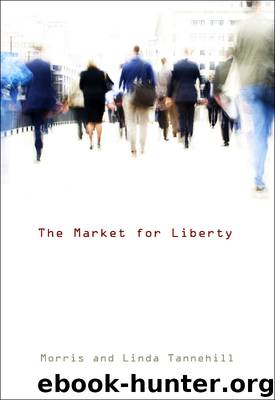The Market for Liberty by Morris & Linda Tannehill

Author:Morris & Linda Tannehill [Morris and Linda Tannehill]
Language: eng
Format: epub
ISBN: 9781610162050
Publisher: The Ludwig von Mises Institute
Published: 2007-11-06T16:00:00+00:00
__________________
1The correctional institutions which would develop in a laissez-faire society will be examined in Chapter 10.
9
Dealing With Coercion
Throughout history, the means of dealing with aggression (crime) has been punishment. Traditionally, it has been held that when a man commits a crime against society, the government, acting as the agent of society, must punish him. However, because punishment has not been based on the principle of righting the wrong but only of causing the criminal “to undergo pain, loss, or suffering,” it has actually been revenge. This principle of vengeance is expressed by the old saying, “An eye for an eye, a tooth for a tooth,” which means: “When you destroy a value of mine, I’ll destroy a value of yours.” Present day penology no longer makes such demands; instead of the eye or the tooth, it takes the criminal’s life (via execution), or a part of his life (via imprisonment), and/or his possessions (via fines). As can be readily seen, the principle—vengeance—is the same, and it inevitably results in a compound loss of value, first the victim’s, then the criminal’s. Because destroying a value belonging to the criminal does nothing to compensate the innocent victim for his loss but only causes further destruction, the principle of vengeance ignores, and in fact opposes, justice.
When an aggressor causes the loss, damage, or destruction of an innocent man’s values, justice demands that the aggressor pay for his crime, not by forfeiting a part of his life to “society,” but by repaying the victim for his loss, plus all expenses directly occasioned by the aggression (such as the expense of apprehending the aggressor). By destroying the victim’s values, the aggressor has created a debt which he owes to the victim and which the principle of justice demands must be paid. With the principle of justice in operation, there is only one loss of value; and, while this loss must initially be sustained by the victim, ultimately it is the aggressor—the one who caused the loss—who must pay for it.
There is a further fallacy in the belief that when a man commits a crime against society, the government, acting as the agent of society, must punish him. This fallacy is the assumption that society is a living entity and that, therefore, a crime can be committed against it. A society is no more than the sum of all the individual persons of which it is composed; it can have no existence apart from, or in contradistinction to, those individual persons. A crime is always committed against one or more persons; a crime cannot be committed against that amorphous non-entity known as “society.” Even if some particular crime injured every member of a given society, the crime would still have been committed against individuals, not society, since it is only the individuals who are distinct, separate, independent, living entities. Since a crime can only be committed against individuals, a criminal cannot be rationally regarded as “owing a debt to society,” nor can he “pay his debt to society:” the only debt he owes is to the injured individual (s).
Download
This site does not store any files on its server. We only index and link to content provided by other sites. Please contact the content providers to delete copyright contents if any and email us, we'll remove relevant links or contents immediately.
International Integration of the Brazilian Economy by Elias C. Grivoyannis(91931)
The Radium Girls by Kate Moore(11930)
Turbulence by E. J. Noyes(7942)
Nudge - Improving Decisions about Health, Wealth, and Happiness by Thaler Sunstein(7622)
The Black Swan by Nassim Nicholas Taleb(7016)
Rich Dad Poor Dad by Robert T. Kiyosaki(6414)
Pioneering Portfolio Management by David F. Swensen(6230)
Man-made Catastrophes and Risk Information Concealment by Dmitry Chernov & Didier Sornette(5926)
Zero to One by Peter Thiel(5691)
Secrecy World by Jake Bernstein(4652)
Millionaire: The Philanderer, Gambler, and Duelist Who Invented Modern Finance by Janet Gleeson(4386)
The Age of Surveillance Capitalism by Shoshana Zuboff(4216)
Skin in the Game by Nassim Nicholas Taleb(4165)
Bullshit Jobs by David Graeber(4101)
The Money Culture by Michael Lewis(4083)
Skin in the Game: Hidden Asymmetries in Daily Life by Nassim Nicholas Taleb(3935)
The Dhandho Investor by Mohnish Pabrai(3706)
The Wisdom of Finance by Mihir Desai(3659)
Blockchain Basics by Daniel Drescher(3511)
